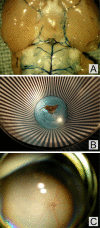Impact of cerebral hypoperfusion-reperfusion on optic nerve integrity and visual function in the DBA/2J mouse model of glaucoma
- PMID: 36161839
- PMCID: PMC9476133
- DOI: 10.1136/bmjophth-2022-001078
Impact of cerebral hypoperfusion-reperfusion on optic nerve integrity and visual function in the DBA/2J mouse model of glaucoma
Abstract
Objective: One of the most important risk factors for developing a glaucomatous optic neuropathy is elevated intraocular pressure. Moreover, mechanisms such as altered perfusion have been postulated to injure the optical path. In a mouse model, we compare first negative effects of cerebral perfusion/reperfusion on the optic nerve structure versus alterations by elevated intraocular pressure. Second, we compare the alterations by isolated hypoperfusion-reperfusion and isolated intraocular pressure to the combination of both.
Methods and analysis: Mice were divided in four groups: (1) controls; (2) perfusion altered mice that underwent transient bi-common carotid artery occlusion (BCCAO) for 40 min; (3) glaucoma group (DBA/2J mice); (4) combined glaucoma and altered perfusion (DBA/2J mice with transient BCCAO). Optic nerve sections were stereologically examined 10-12 weeks after intervention.
Results: All experimental groups showed a decreased total axon number per optic nerve compared with controls. In DBA/2J and combined DBA/2J & BCCAO mice the significant decrease was roughly 50%, while BCCAO leaded to a 23% reduction of axon number, however reaching significance only in the direct t-test. The difference in axon number between BCCAO and both DBA/2J mice was almost 30%, lacking statistical significance due to a remarkably high variation in both DBA/2J groups.
Conclusion: Elevated intraocular pressure in the DBA/2J mouse model of glaucoma leads to a much more pronounced optic nerve atrophy compared with transient forebrain hypoperfusion and reperfusion by BCCAO. A supposed worsening effect of an altered perfusion added to the pressure-related damage could not be detected.
Keywords: Anatomy; Experimental & animal models; Glaucoma; Optic Nerve.
© Author(s) (or their employer(s)) 2022. Re-use permitted under CC BY-NC. No commercial re-use. See rights and permissions. Published by BMJ.
Conflict of interest statement
Competing interests: None declared.
Figures




Similar articles
-
Inducible nitric oxide synthase, Nos2, does not mediate optic neuropathy and retinopathy in the DBA/2J glaucoma model.BMC Neurosci. 2007 Dec 19;8:108. doi: 10.1186/1471-2202-8-108. BMC Neurosci. 2007. PMID: 18093296 Free PMC article.
-
Mitochondrial morphology differences and mitophagy deficit in murine glaucomatous optic nerve.Invest Ophthalmol Vis Sci. 2015 Feb 5;56(3):1437-46. doi: 10.1167/iovs.14-16126. Invest Ophthalmol Vis Sci. 2015. PMID: 25655803 Free PMC article.
-
Involvement of endoplasmic reticulum stress in optic nerve degeneration after chronic high intraocular pressure in DBA/2J mice.J Neurosci Res. 2015 Nov;93(11):1675-83. doi: 10.1002/jnr.23630. Epub 2015 Aug 13. J Neurosci Res. 2015. PMID: 26271210
-
Ocular Treatments Targeting Separate Prostaglandin Receptors in Mice Exhibit Alterations in Intraocular Pressure and Optic Nerve Lipidome.J Ocul Pharmacol Ther. 2023 Oct;39(8):541-550. doi: 10.1089/jop.2023.0006. Epub 2023 Jun 2. J Ocul Pharmacol Ther. 2023. PMID: 37267222 Free PMC article.
-
Glaucoma as a Metabolic Optic Neuropathy: Making the Case for Nicotinamide Treatment in Glaucoma.J Glaucoma. 2017 Dec;26(12):1161-1168. doi: 10.1097/IJG.0000000000000767. J Glaucoma. 2017. PMID: 28858158 Free PMC article. Review.
Cited by
-
The role of corneal biomechanics in visual field progression of primary open-angle glaucoma with ocular normotension or hypertension: a prospective longitude study.Front Bioeng Biotechnol. 2023 May 10;11:1174419. doi: 10.3389/fbioe.2023.1174419. eCollection 2023. Front Bioeng Biotechnol. 2023. PMID: 37234476 Free PMC article.
References
-
- GBD 2019 Blindness and Vision Impairment Collaborators, Vision Loss Expert Group of the Global Burden of Disease Study . Causes of blindness and vision impairment in 2020 and trends over 30 years, and prevalence of avoidable blindness in relation to vision 2020: the right to sight: an analysis for the global burden of disease study. Lancet Glob Health 2021;9:e144–60. 10.1016/S2214-109X(20)30489-7 - DOI - PMC - PubMed
